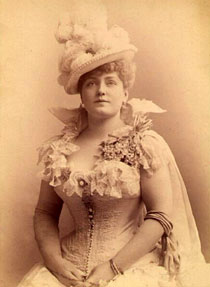 Lillian Russell
Lillian RussellThe late 1800s was one of the few periods in history when slimness was not considered desirable. Women were supposed to have big busts and wide hips. Waists, however, were supposed to be small, and women still wore tight corsest to squeeze theri waists in. An Englishman reported that American women seemd to be morbidly frightened of getting thin. "They are constantly having themselves weighed and every ounce of increase is hailed with delight, and talked about with the most dreadful plainness of speech" he reported. A "beautiful Connecticut girl" he added, told him proudly that she had "gained eighteen pounds in flesh since last April."
The great American beauty of the age was Lillian Rusell, famed singer, actress, and dinner partner of Diamond Jim Brady. At her thinnest, the five-foot, five-inch Russell weighted about 140 pounds, but she frequently exceeded 160.
Dance troupes from Europe that toured the United States featured chorus girls who were definitely Rubenesque and American stage shows followed their lead. In the 1890s, Metropolitcan Magazine claimed that the "regulation chorus girl type" had "thick ankles, ponderous calves and a waist laced so tight that the lines of the hips and bust were distorted into balloon-like curves." Perhaps fleshiness was appropritae in an era when Americans finally discovered the joys of appetite. Or perhaps it was a reaction against the "fairylike" women of the pre-Civil War era. Helen Hunt, a widow who had gone west in 1872 to escape ill health and depression, wrote to her sickly friends proudly reporting that she now weighted 163 pounds.
Photography became common, and when women had their pictures taken they demanded that theri cheekss look redder, their skin whiter, their hair brighter, until, one photographer complained, the subjects "looked like ghastly mockery of the clown in a pantomime." It was only a small step from tinted photography to tinted faces. Makeup was still considered the mark of a fast women, but the late-nineteenth-century equivalent of the jet-set used it anyway. Fashionable women used hot tongs to curl their hair into effortful coiffures, which were sprinkled with gold or silver dust for special occasions. They wore elaborate hats - huge affairs bearing flowers, lace, organdy, and every possible kind of feathers, from ostrich plumes to stuffed birds. The slaughter of wild birds for hat decorationss reached such outrageouss proportions that it led to the nation's first public environmental protests.
Source(s):
America's Women, 400 Years of Dolls, Drudges, Helpmates and Heroines by Gail Collins
No comments:
Post a Comment